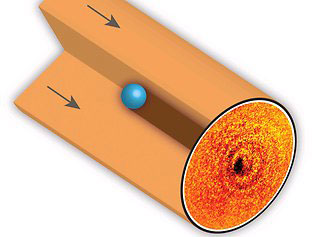| Jul 03, 2012 |
First photo of atom's shadow
|
|
(Nanowerk News) A pixelated image of a black spot on an orange background isn't likely to win any photographic competitions.
|
|
But the seemingly bland image, taken by scientists at Queensland's Griffith University, could potentially revolutionise mankind's understanding of physics and how the world works.
|
|
A research team at the university's centre for quantum dynamics in Brisbane has been able to photograph the shadow of a single atom for the first time (see paper in Nature Communications: "Absorption imaging of a single atom").
|
 |
| Artist's illustration of a single atom shadow. (Image: Kielpinski group, Griffith University)
|
|
Professor Dave Kielpinski says the image is at the extreme limit of microscopy.
|
|
"You cannot see anything smaller than an atom using visible light," Prof Kielpinski said in a statement.
|
|
"We wanted to investigate how few atoms are required to cast a shadow, and we proved it takes just one."
|
|
The scientists used a super high-resolution microscope not available anywhere else in the world.
|
|
A single atom of the element ytterbium was held by electrical forces and exposed to a specific frequency of light, which caused it to cast a shadow that could be photographed.
|
|
Research team member Erik Streed said the photo had myriad implications, including revolutionising quantum computing and biomicroscopy.
|
|
"Because we are able to predict how dark a single atom should be, as in how much light it should absorb in forming a shadow, we can measure if the microscope is achieving the maximum contrast allowed by physics," Dr Streed said.
|
|
"This is important if you want to look at very small and fragile biological samples such as DNA strands where exposure to too much UV light or x-rays will harm the material."
|

